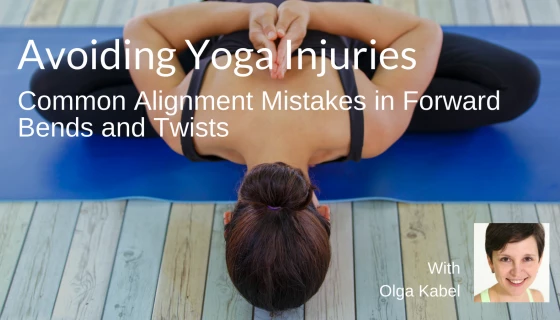Healthy Forward Bending: Is Rolling Up from Forward Bends Safe?
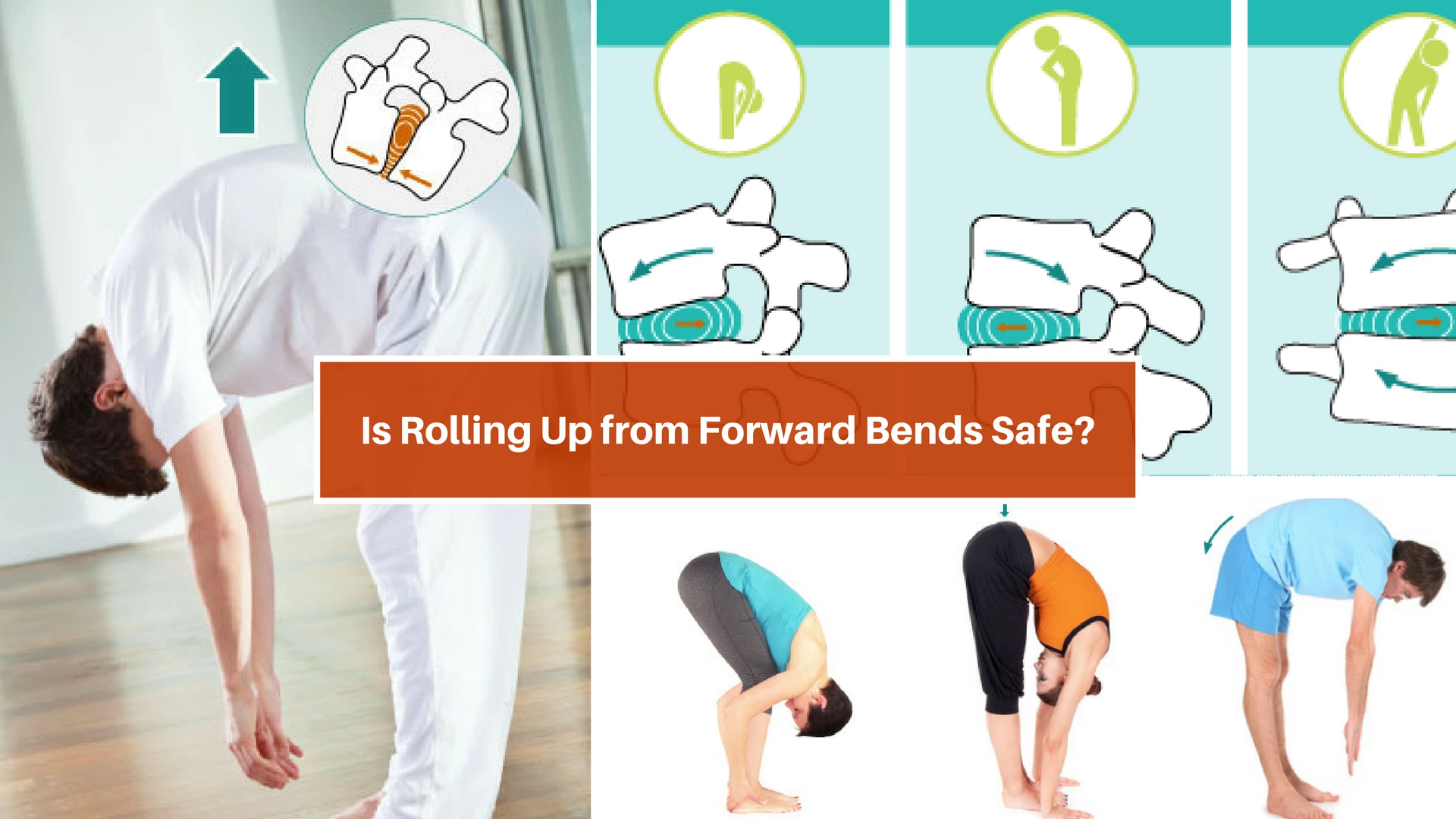
Recently I’ve watched a video on YouTube by a popular yoga teacher and couldn’t help but wince every time she instructed her students to “roll up to stand one notch at a time”. Why was I wincing? Because every time I heard that I was imaging what was happening to the student’s lumbar spine and it wasn’t pretty. This “roll up move” is so popular in yoga classes; it can’t be bad if everybody is doing it, right? Hmm, let’s take a look… 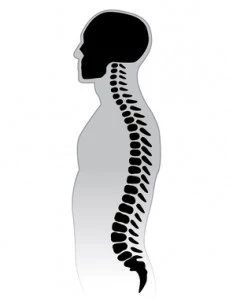
Here is your spine. Your lumbar spine curves in to accommodate the weight of the structures above it (cervical and thoracic spine; ribcage, head and their contents). Between the bony vertebral bodies you have spinal discs.
The nucleus of the disc acts as a shock absorber, absorbing the impact of the body’s daily activities and keeping the two vertebrae separated. The disc is like a jelly doughnut: the strong outer layer (annulus fibrosis) is similar to the dough and the gel-like center (nucleus pulposis) is the jelly. For example, if one presses down on the front of the doughnut the jelly moves posteriorly (to the back).
Here is what happens to your discs in a yoga class or in your day-to-day life (see below): they get slightly squeezed from different angles depending on the position of your spine. This is actually a good thing because it keeps them nourished and healthy.
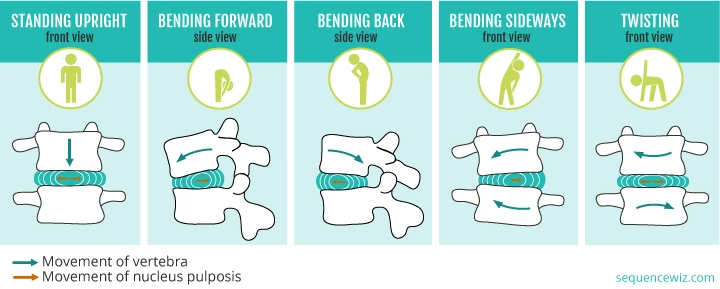
The problems arise when we put too much pressure on the disc. We all know that to have a “disc problem’ in any form is not preferable, to say the least. And it is certainly not advisable to do things that can potentially create “disc problems.” Let’s now look at our forward bend. The degree of the forward tilt of the pelvis will depend on the condition of your hamstrings.
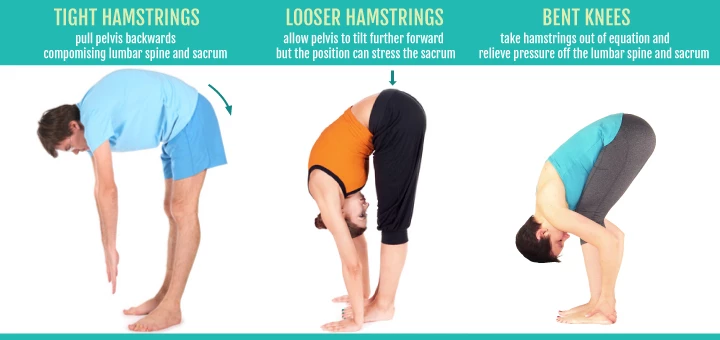
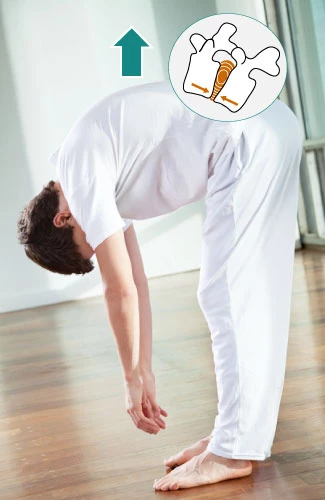 When the hamstrings are tight (especially if you insist on keeping the legs straight) they will prevent the pelvis from tilting forward, which means that the bend will come from the lumbar/thoracic spine. In the neutral position your lumbar spine is concave (curves inward), in forward bend you are placing it in a convex position (bulges outward), which means that the discs will be squeezed at the front, creating “anterior disc compression”. Already this is risky for your lumbar spine. That’s why if your hamstrings are tight we usually recommend that you keep your knees slightly bent to allow the pelvis to tilt further forward.
When the hamstrings are tight (especially if you insist on keeping the legs straight) they will prevent the pelvis from tilting forward, which means that the bend will come from the lumbar/thoracic spine. In the neutral position your lumbar spine is concave (curves inward), in forward bend you are placing it in a convex position (bulges outward), which means that the discs will be squeezed at the front, creating “anterior disc compression”. Already this is risky for your lumbar spine. That’s why if your hamstrings are tight we usually recommend that you keep your knees slightly bent to allow the pelvis to tilt further forward.
Now imagine rolling up from this position. You are asking your lumbar discs to bear the weight of your head (heavy), cervical/thoracic spine (heavy), ribcage (very heavy) plus brain, organs, etc. Wow, that’s a lot of work for few little guys!
Because of your body’s position in relation to gravity, your core musculature cannot help much. So now your lumbar discs are being squished by the vertebrae at the front and nucleus (jelly center) is being pushed back with tremendous force generated by the weight of your upper body. And for what purpose exactly? So that you could stretch the back of your body? There are better ways of accomplishing that in a safer way.
Interestingly, if you change your position in relation to the ground, the load on the discs will change also. Consider a “roll-down”. 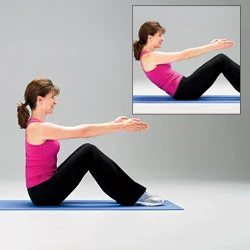
Here you are working with gravity, not against it, which diminishes the pressure on the discs. And more important, here you can use your abdominal muscles to decelerate your descent, which means that your spine is now supported by your core musculature.
Here is the bottom line: rolling up into standing position can create anterior disc compression. And it doesn’t matter how loose or tight your hamstrings are. If your hamstrings are tight you are risking disk compression any time you bend forward (bending your knees will diminish that risk significantly).
This is one of those things that probably won’t show up after one yoga class, or may be even 10 classes, but it can create disc problems down the line. Why risk it? The risk here far outweighs the potential benefit.
If we don’t roll up, then how do we come up into the standing position? We do it by leading with the chest and strengthening your lower back muscles instead of trying to stretch them.
Here is how:
-
Prepare to move up into standing.
-
Start by leading with your chest, moving the upper body up until you return into the neutral lumbar curve (about parallel to the ground).
-
Continue to move up with your upper body and your pelvis moving as a unit now to maintain the neutral curve in your lower back. Lifting up in this way will strengthen your back.
If this is a new move for you, keep your hands sliding up your legs to minimize the load on your back. Once you become more comfortable you can move the arms out to the sides or all the way forward (most difficult).
Yoga Demonstration Video
Here is a short video to illustrate the point:
Yoga Anatomy: To learn more about your knee joint and how it works, read Olga Kabel’s “The Knee Joint—Much More than a Simple Hinge and Why it Matters.”
Study more anatomy with Olga Kabel and YogaUOnline: Avoiding Yoga Injuries – Common Alignment Mistakes in Forward Bends and Twists.
This article is reprinted with permission from sequencewiz.com.
 Educated as a school teacher, Olga Kabel has been teaching yoga for over 14 years. She completed multiple Yoga Teacher Training Programs, but discovered the strongest connection to the Krishnamacharya/ T.K.V. Desikachar lineage. She had studied with Gary Kraftsow and American Viniyoga Institute (2004-2006) and received her Viniyoga Teacher diploma in July 2006 becoming an AVI-certified Yoga Therapist in April 2011. Olga is a founder and managing director of Sequence Wiz- a web-based yoga sequence builder that assists yoga teachers and yoga therapists in creating and organizing yoga practices. It also features simple, informational articles on how to sequence yoga practices for maximum effectiveness. Olga strongly believes in the healing power of this ancient discipline on every level: physical, psychological, and spiritual. She strives to make yoga practices accessible to students of any age, physical ability and medical history specializing in helping her students relieve muscle aches and pains, manage stress and anxiety, and develop mental focus.
Educated as a school teacher, Olga Kabel has been teaching yoga for over 14 years. She completed multiple Yoga Teacher Training Programs, but discovered the strongest connection to the Krishnamacharya/ T.K.V. Desikachar lineage. She had studied with Gary Kraftsow and American Viniyoga Institute (2004-2006) and received her Viniyoga Teacher diploma in July 2006 becoming an AVI-certified Yoga Therapist in April 2011. Olga is a founder and managing director of Sequence Wiz- a web-based yoga sequence builder that assists yoga teachers and yoga therapists in creating and organizing yoga practices. It also features simple, informational articles on how to sequence yoga practices for maximum effectiveness. Olga strongly believes in the healing power of this ancient discipline on every level: physical, psychological, and spiritual. She strives to make yoga practices accessible to students of any age, physical ability and medical history specializing in helping her students relieve muscle aches and pains, manage stress and anxiety, and develop mental focus.


